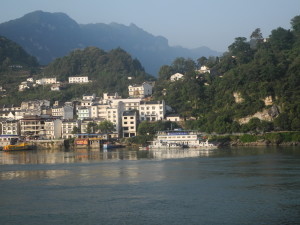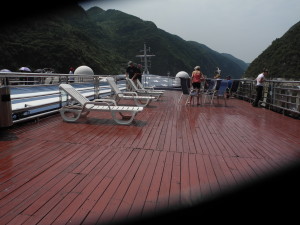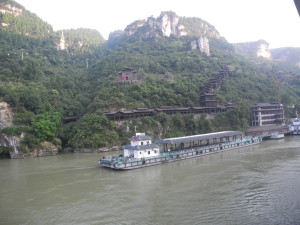
The Xiling Gorge, one of the Yangtze’s famous Three Gorges, begins near Yichang. Photo by Catharine Norton.
Fourth in a Series:
There are a number of iconic river cruises in the world — the Rhine, the Danube, the Amazon, and the Nile among them — and China’s Yangtze must be added to the group.
It’s China’s longest river and third longest in the world after the Nile and Amazon. “Yangtze,” in fact, means “long river” in Chinese. Also known as the “Golden Highway,” the Yangtze is the busiest river in the world and more than one-third of China’s 1.4 billion population live along it.
The Yangtze is actually divided into seven separate sections, but the part that most people cruise — and certainly the most scenic — is the 400-mile-long “Three Gorges” section between the cities of Yichang and Chongqing, a sprawling metropolis in southwest China.
My wife, Catharine, and I recently sailed this section aboard the Victoria Katarina, one of seven ships operating on the river by Victoria Cruises, the only American-owned company running cruises on the Yangtze.
Most people opt for the cruise that starts in Chongqing and sails downriver to Yichang — a faster trip (four days and three nights) because you’re traveling with the current. We chose the slower version — five days and four nights going upstream — for the very reason that we would get to spend more time on the ship.
And the Katarina is a beautiful ship, recently refurbished, with six decks (including an open-air sun deck), two dining spots, a large lounge, a small fitness center, a massage salon, a medical clinic, and a passenger capacity of around 250 people.
Interestingly, there were very few Americans aboard our cruise — five to be exact, including Catharine and I and the cruise director, Darby, who hails from Las Vegas. There was also a man from Mississippi and another from Portland, Oregon.
Otherwise, the cruise was filled with Aussies, Brits, Germans, Italians, and lots of Chinese — perhaps half the total passengers. The captain and crew were Chinese, the restaurant servers were Chinese, the housekeepers were Chinese, and the announcements were made in both English and Chinese. Sightseeing tours also were divided among Chinese and English speakers, though the Germans, part of a tour group, had their own guides.
I’m not sure about some of the Chinese aboard, but all the Westerners except for Catharine and me were there as parts of tour groups. I had won the cruise in a travel-writing contest and we had traveled on our own to Shanghai and Yichang for several days before boarding, so first we had to find the ship.
Our Search for the Ship
As I wrote in a previous post, we stayed in Yichang at a classic older hotel called the Taohualing, and the staff couldn’t have been friendlier or more accommodating to us. They just couldn’t speak English, for the most part — and why should they? We were the only Westerners staying there.
What we needed to find was the New Century Port, one of three river cruise ports in Yichang, and, as far as we could discern, located somewhere outside the city. Someone we met on the street said it was “very far” — “at least five kilometers” (three miles) while another figured it was 13 miles away.
None of the hotel staff seemed to have heard of it, which surprised us, even after we found someone to write the name down in Chinese. The bellboy looked the piece of paper over with a serious expression before handing it to the concierge, who puzzled over it for a while before handing it to the manager, who brought it back to us and said, “Taxi,” but didn’t know to where.
So, Chinese name in tow, we handed it to a taxi driver, placing our fate in his hands and his rather heavy foot on the accelerator. He drove and drove — this was definitely the 13-mile version — until we spotted signs pointing toward “Xiling Scenic Tourist Area.” That was good news, since the first of the Three Gorges is called Xiling.
Soon we were crossing the Yangtze at an extraordinarily scenic spot with dramatic gorges risong on both sides. We would have loved to get out right there, but the taxi continued down a narrow, winding, barely paved road until he disgorged us at an entrance gate, handed us our luggage and accepted his payment. It was very reasonable assuming this was indeed the right port.
Rolling our bags down the hill, we heard a young woman ask: “Are you looking for the Katarina?”
It was the best thing we’d heard since we’d been in China.
Up Next: Sailing The Three Gorges With Victoria Cruises
Travel Tip of the Day: Wherever you travel in China, bring your own hand sanitizer — public bathrooms seldom have soap, paper towels or hand driers of any sort. Even on a cruise ship, which does provide soap, it’s a good idea to use hand sanitizers to help avoid catching one of the nasty viruses that hang around hand railings and such. (This same advice applies to any cruise ship, anywhere — or, for that matter, to just about anywhere you travel where you can’t often wash your hands.)
Readers: You can subscribe to my blog and get notification of every post by simply typing in your email address and clicking on the blue Subscribe button or downloading my free report, How to Ride the Coming Wave of Boomers. Thanks!














Leave a Reply